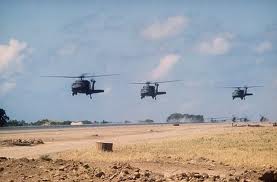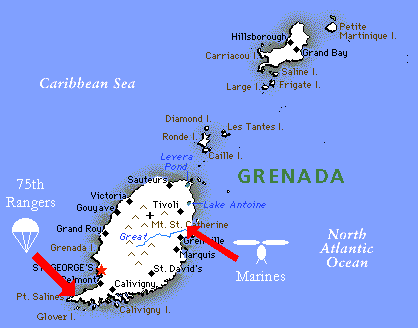|
UH-60A
Black Hawks over Port
Salinas,invasion of Grenada,
1983 The
invasion of Grenada in late 1983 can
be seen as a small part of the
rivalry between the U.S. and Cuba
during the Reagan years. A bloody
coup in Grenada, along with a
perceived threat to American
students on the island provided the
U.S. with an excellent excuse to
eliminate a Marxist regime allied to
Fidel Castro's Cuba. Page
Menu :Click
on the menu bar below to navigate
this page. Name
of
Conflict
|
Belligerents
| Conflict
Dates
| Conflict
Type
| Related
Conflicts
| Causes
|
Description
|
Consequences
|
Casualties
| Unique
Facts or
Trends
| Sources
| Links NAME
OF CONFLICT: The U.S. Invasion of
Grenada ALTERNATE
NAMES: Operation Urgent Fury
(US) United
States and the Organization of
Eastern Caribbean States vs. Grenada
and Cuba BEGAN:
October 25, 1983 ENDED:
December, 1983 TYPE(S)
OF CONFLICT:
Inter-State
(between nations) PREDECESSOR: CONCURRENT:
The Cold War, U.S. Intervention in
Lebanon (1982-1984), Nicaraguan
"Contra" War (1982-1990) SUCCESSOR: The
U.S. invasion of Grenada and the
toppling of its Marxist government
can be seen as part of a greater
regional conflict. This conflict
involved the U.S. and its Central
American and Caribbean allies on one
side and Fidel Castro's Cuba, the
Sandinista government of Nicaragua
and various Marxist guerrilla armies
on the other. President Reagan and
his administration were concerned
that the Marxist government of Prime
Minister Maurice Bishop was allowing
Cuba to gain undue influence in
Grenada, specifically by
constructing a military-grade
airport with Cuban military
engineers. On
October 13, 1983, the Grenadian
Army, controlled by former Deputy
Prime Minister Bernard Coard, seized
power in a bloody coup. The severity
of the violence, coupled with
Coard's hard-line Marxism, caused
deep concern among neighboring
Caribbean nations, as well as in
Washington, D.C. Also, the presence
of nearly 1,000 American medical
students in Grenada caused added
concern. However,
along with concern, came
opportunity. With President Reagan's
worldwide efforts to confront what
he viewed as the threat by the
Soviet Union and other Communist
countries (such as Cuba), the
turmoil in the Caribbean provided a
timely excuse to eliminate a Marxist
government and give Fidel Castro a
black eye. It
should also be noted that on October
23, 1983, American foreign policy
and pride suffered a terrible shock
when a Muslim suicide bomber
destroyed the Marine barracks in
Beirut, killing 240 U.S. Marines. A
successful campaign in Grenada would
prove helpful in alleviating the
pain of that setback. In
the early morning of October 25,
1983, the United States invaded the
island of Grenada. The initial
assault consisted of some 1,200
troops, and they were met by stiff
resistance from the Grenadian army
and Cuban military units on the
island. Heavy fighting continued for
several days, but as the invasion
force grew to more than 7,000, the
defenders either surrendered or fled
into the mountains. Scattered
fighting continued as U.S. troops
hunted down stragglers, but for the
most part, the island quickly fell
under American control. By
mid-December, U.S. combat forces
went home and a pro-American
government took power. 1.
The Marxist, pro-Cuban governments
of Bishop and Coard were eliminated
and a regime friendly to American
interests took over. 2.
The Reagan Administration proved
willing to use force to combat what
it considered hostile governments in
the area. 3.
America's European allies expressed
disapproval of the unilateral
invasion of Grenada. 4.
The invasion sent a message to Cuba
and Nicaragua that they could only
go so far in exporting revolution in
Central America and the Caribbean
without provoking an American
military response. 5.
As a result of the Cuban defeat in
Grenada, Colonel Pedro Tortolo, who
was the commander of Cuban military
personnel on Grenada when the U.S.
forces invaded, was court-martialed
and sent to Angola as a private,
along with most of his Grenada
command. U.S.--
19 dead (officially). Grenada--
49 dead and several hundred
wounded. Cuba--
29 dead and over a hundred
wounded. UNIQUE
FACTS OR TRENDS:
This
section is formed from the opinion
of the History Guy regarding this
conflict. 1.
This was the first "war" between the
U.S. and Cuba. Though some would say
that the Bay of Pigs Invasion of
1961 could fall into that category,
we do not count the Bay of Pigs in
the category of an "official"
shooting war or conflict. 2.
Grenada was America's first military
victory since well before the
Vietnam War. 3.
This was the first time since before
World War Two that an avowed
Communist/Marxist government had
been replaced with a pro-Western
one. It should be noted though, that
some governments which the United
States and her allies claimed were
communist (like the Arbenz
government of Guatemala and the
Mossadegh regime in Iran) did fall
due to covert American (CIA) action.
Again, we do not count them since
they did not officially proclaim
allegiance to the communist ideology
or become overt allies of other
communist nations. Something
new and historical: Want to learn
how to drive a tank? Check out these
tank
driving
experiences.
1.
Kohn, George C.
Dictionary
of Wars.
New
York: Facts On File Publications.
1986. Get
MCSA
2003
demos for ccda
exam
training when you cissp
certification
with 100% success guaranteed. Our
high quality 642-902
prepares you well before appearing
in the final exams of
VCP-510
study guide. See also:
Wars
of Cuba Joseph
Metcalf III Dies at 79; Led Invasion
of Grenada The
Military History of the Ranger:
Grenada
Invasion
An account of the U.S. Army Rangers
in action in Grenada. Operation
Urgent
Fury
A good source for links on the
Grenada conflict. U.S.
Casualties from Operation Urgent
Fury--From
the U.S. Army web site. Lebanon And
Grenada
Transcript of President Reagan's
address to the nation regarding the
bombing of the Marine barracks in
Lebanon and the U.S. invasion of
Grenada. Part of a larger Ronald
Reagan website. Great
Events IV: The Invasion of
Grenada
Primarily a political analysis of
the reasons behind the Grenada
invasion. Serves as a good summary.
These articles are excerpted from
Great Events VI, based on reporting
by The New York Times. The
Grenada 17
Homepage--Supports
of the release of fourteen former
members of the Grenada government of
1979 to 1983 and the three soldiers
imprisoned with them. Fort
George Grenada, West
Indies--Very
interesting history of a military
fort in Grenada, from colonial times
to the U.S. invasion. This fort was
previously known as Fort
Rupert. Grenada
Revolution
Online--Learn
the basics of the story of The
Grenada Revolution online. In 1983,
the United States was part of
Grenada's history. Discover what
happened and why. "The
History Guy" is a Registered Trademark. Contact
the webmaster |

